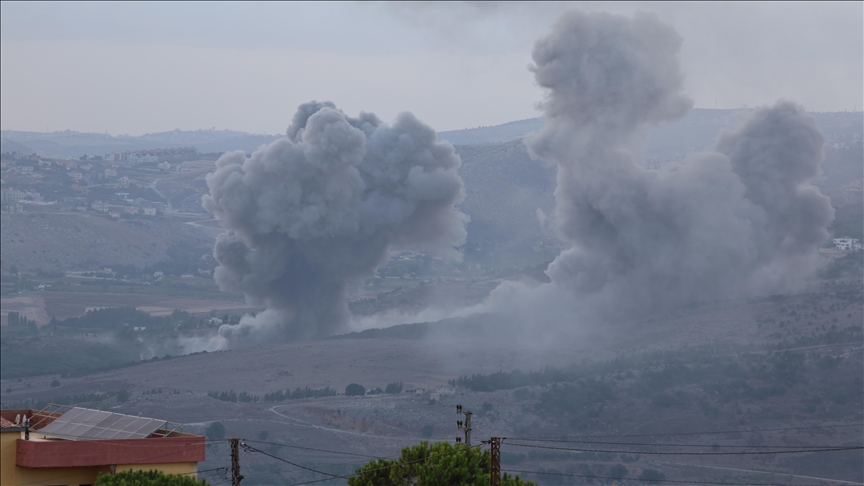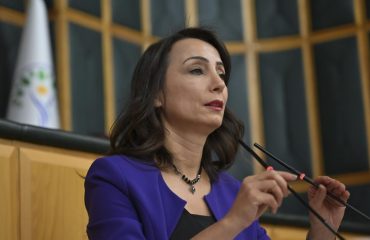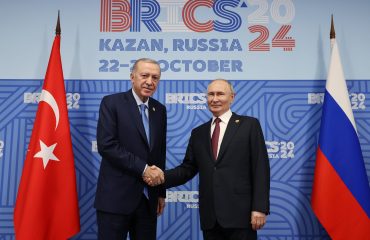

The situation in Lebanon has taken a precarious turn, as highlighted by Israel’s recent attacks on Hezbollah. The country finds itself at risk of descending into a more complex and potentially bloodier conflict than it has seen before. This escalation is pushing Lebanon to its limits, with the potential for spillover effects reaching as far as Syria. (Photo: AA)
The situation in Lebanon has taken a precarious turn, as highlighted by Israel’s recent attacks on Hezbollah. The country finds itself at risk of descending into a more complex and potentially bloodier conflict than it has seen before. This escalation is pushing Lebanon to its limits, with the potential for spillover effects reaching as far as Syria.
A critical question emerges: Is Hezbollah being drawn into a conflict that the Lebanese people neither want nor can afford to witness?
Lebanon’s social fabric is intricate, comprising 18 distinct ethnic, religious, and sectarian groups. The country also hosts 12 Palestinian refugee camps, which were central to the previous civil war. With a population of six million, Lebanon is experiencing a rapid demographic shift favoring Sunni and, more significantly, Shia Muslims. Meanwhile, the Maronite Christian community continues its long-standing aspiration for an independent state within Lebanon, a dream dating back to Ottoman rule.
Potential scenarios in Lebanon
Could Israel’s actions against Hezbollah inadvertently catalyze the realization of Lebanese Christians’ centuries-old dream of an independent state or confederation?
In Syria, might Bashar al-Assad seize this moment to establish an independent Alawite republic, stretch from Daraa and Damascus, through Homs, to the Mediterranean coast, encompassing Tartus and Latakia? This move could be aimed at mitigating Sunni and Kurdish opposition, as well as reducing Iranian influence. It’s worth noting that similar proposals were considered a century ago, underscoring the historical depth of these geopolitical considerations.
The repercussions could extend to Turkey’s borders, where complexities already exist due to the presence of various actors including Russia, the USA, and Kurdish groups along the 911 km border. Additionally, the situation in Idlib, with its large Sunni population contemplating migration to Turkey and the presence of Salafi-takfiri groups, remains a significant concern.
The Sunni communities in northern Lebanese cities like Tripoli and Akkar, along with Cretan Turks and Turkmens, maintain close ties with Turkey across the Mediterranean. This highlights the intricate web of regional affiliations, where different Lebanese communities look to external powers for support: Christians to France, Shias to Iran, and Sunnis and Turkmens to Turkey.
MOSSAD’s intelligence feat
Israel’s recent operations demonstrate a clear psychological and tactical edge. The simultaneous targeting of around 5,000 objectives showcases a remarkable intelligence feat, likely involving sophisticated field operations and data analysis. This success spans a wide geographical area, encompassing Taiwan, Hungary, and Lebanon, and represents an intelligence achievement that rivals those of agencies like the CIA and MI6.
So how does the Lebanese Army Command (LAF) position itself? It has no position. Their silence during the 11-month conflict in Gaza and in response to Israeli incursions into Lebanese airspace and territory is telling. The LAF’s leadership structure, with a Maronite commander and a Shia deputy, reflects Lebanon’s delicate sectarian balance.
However, the significant Shia presence in the LAF’s rank and file suggests that in a potential Hezbollah-Israel conflict, many might align with Hezbollah.
What could the counterespionage units of four separate intelligence services in Lebanon, whose directors are Sunni, Shia, Maronite, and Orthodox, do?
Israel’s shifting strategy
Israeli Defense Minister Yoav Galant stated on the evening of September 18 that “Israel needs to adapt to the new phase of the war,” while Saudi Crown Prince Mohammed bin Salman said they “will not have ties with Israel until a Palestinian State is established.” The UAE is speaking from the same perspective, putting the Abraham Accords on hold.
Israeli Prime Minister Benjamin Netanyahu is taking new positions uncontrollably before the US elections. A savage war is at the door. As the crimes against humanity amounting to genocide that have been continuing in Gaza for 11 months go unpunished, it has become impossible to stop Israel led by Netanyahu.
The rules-based international order is giving way to lawlessness. An order where lawlessness is the rule, with contributions from Russia and Israel.
Netanyahu, based on the support he received from his speech in the US Congress a few months ago, is uncontrollably going after geopolitical risks. Netanyahu appears to be taking increasingly aggressive positions, possibly emboldened by support from the US Congress and speculated encouragement from former President Trump.
As of September 8, Netanyahu is moving his 98th Division from Gaza to the north, to the Lebanese border. The strategic playing field is Lebanon.
Hezbollah’s vulnerabilities exposed
Recent attacks have reportedly inflicted more damage on Hezbollah than publicly acknowledged. There are indications that Hezbollah is struggling to provide medical care to its injured members, resorting to makeshift facilities in tunnels. The organization faces unprecedented challenges, including disrupted communication systems and leadership structures.
Hezbollah leader Sheikh Hassan Nasrallah’s recent speech offered little new information, suggesting potential internal difficulties. Despite its formidable hybrid military capabilities, Hezbollah has shown weaknesses in counterintelligence, a critical vulnerability in the face of sophisticated Israeli operations.
Lebanon’s sectarian dynamics
Lebanon’s complex sectarian landscape has deep historical roots. The country has seen shifts in power dynamics from Ottoman-era Sunni prominence to French mandate-era Christian dominance, with Shias historically marginalized. These historical grievances, combined with anti-Israel sentiment and Iranian influence, contributed significantly to Hezbollah’s formation and ongoing appeal.
Hezbollah’s human resources are uninterrupted; there are many people affected by Israel’s decades-long attitude contrary to human rights who want to join Hezbollah to become “martyrs”. After what happened in Gaza, there are many people, even children and adolescents, who are candidates for Hezbollah/Hamas/Islamic Jihad.
In Lebanon, despite its Shia infrastructure and priority, Hezbollah became a role model for actors on the resistance axis against Israel, such as Sunni Hamas and Palestinian Islamic Jihad. Various Palestinian factions in Lebanon could come together in Hezbollah’s operations room in Beirut.
Hezbollah blind and deaf
The Hezbollah leadership must be looking for a way out, deaf and blind, without secure communication after the recent attacks. The hand of Israeli intelligence could reach as far as Iran’s Ambassador to Beirut, Mujtaba Amani. The secure communication of Hezbollah’s top management with field commanders, and even with Iran, must have been cut off.
While Hezbollah’s command echelon cannot communicate securely within itself or come together under the same roof, could a Hezbollah commander, in the face of a sudden Israeli threat, make an emotional move and fire the missiles?
During the Cold War, the US and Russia, NATO and the Warsaw Pact, as state/supranational security organizations, somehow took precautions against this. They were able to manage crises and risks with multiple security and authority definitions.
Broader regional implications
A particularly concerning scenario is the potential for unilateral action by Hezbollah commanders if communication chains break down. The rigid hierarchical structure of Hezbollah, combined with potential communication disruptions, could lead to unauthorized missile launches with catastrophic consequences for all parties involved.
Although Hamas has tactically lost power in Gaza over the last 11 months, it is still standing and doesn’t seem to be about to collapse. Hezbollah may also be wounded but will continue to exist much stronger than Hamas. Israel should not forget that it has to live in the same geography with Hezbollah as with Hamas.
In light of these developments, another risk in the current conjuncture is the possible and uncontrolled reactions of other Iranian proxies in Yemen and Iraq, with the Israeli-Lebanese front expanding to include Syria. There is a high possibility of expansion not only towards Israel but also to include the entire Eastern Mediterranean and Red Sea.
Mossad: From October 7 to September 17
There is a saying attributed to Israel in the Middle East: “Be willing to extend your hand to shake hands with your enemy, but keep your other hand on the gun in your pocket. Now is not the time for naivety. Also, keep your enemies close.”
Netanyahu broke the clichés. He has guns in both hands. In one hand conventional weapons, in the other hand artificial intelligence, computer keys with the latest techniques of cyber attack. Also, there is the possibility of obtaining qualified and up-to-date intelligence from within the target through infiltrations.
This was seen more clearly in the Lebanon operations.
The question that comes to mind is; How did Mossad, which has the power to obtain qualified and timely information from within the target from Beirut to Damascus and Tehran and quickly turn it into an operation, fail to get intelligence about the October 7 attacks, the preparations for which would take more than a year?
Is the weakness here political or does it stem from Mossad managers experiencing power intoxication? Or are these the footsteps of a multinational geostrategic planning?


